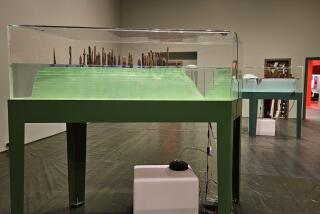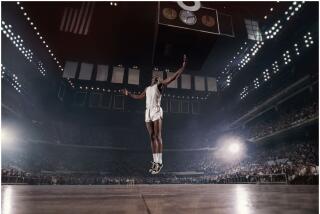Review: Carl Cheng’s ‘Ghost Fish 107’ strikes cautionary note
- Share via
The unblinking eye in a big new sculpture of a bluefin tuna by Carl Cheng contains a live-feedback television screen.
Approach the monumental, 40-foot-tall fish, which is suspended by its tail from a galvanized steel frame over water dotted with concrete pilings at Berth 73 on the San Pedro harbor front, and the eye appears unexpectedly animated. Peer in closely, and you’ll be surprised to see your own quizzical face staring back.
“Ghost Fish 107,” unveiled last week, is a public sculpture commissioned by the Port of Los Angeles for a new plaza near a waterfront fishing slip. (The number 107 refers to January 2007, the date of Cheng’s initial design.) On the surface it commemorates the once-thriving tuna fishing and canning industry at the site, which dates to the first years of the 20th century. The business peaked after World War II -- in 1957 a tuna was even added to the Spanish galleon, engineering instruments and other civic symbols on the L.A. County seal -- and it began shutting down a generation ago.
Yet that disembodied eye in the sculpture suggests something deeper than a simple memorial. The monument commemorates an industry, but it also memorializes a vanishing connection between humanity and nature. A similar cautionary note has appeared in other works by Cheng.
Cheng’s sculpture is an open-framework design, a stainless steel cage sheathed in metal netting. Hooks, pulleys, heavy duty locks, gauges and other maritime objects hang from the net, while a dense mound of actual buoys, tools, ropes, license plates and other detritus rests at the bottom, inside the transparent creature’s head.
So does a solar-powered video camera. Thanks to the eye, your image also hovers inside with all the cast-off trash, as if it has been swallowed whole like some latter-day, unrepentant Jonah.
Like Martin Puryear’s open-framework sculpture, “That Profile,” on the Getty Center plaza, made from knotted metal rods that mimic reed basketry, the forms of “Ghost Fish 107” fuse industrial materials with handcrafted items. (An actual fishnet climbs up one side of the fish, intermingled with the steel netting). On the adjacent fishing slip plaza, wooden seating whose cubic, modular designs were adapted from traditional packing crates by artist Harold Greene underscores the emphasis on handmade craft.
Ghost fishing, according to the United Nations’ Food and Agriculture Organization, is a term used for lost or abandoned fishing gear in the seas, lakes or rivers -- gear that continues to passively make its catch. Cheng’s monumental “Ghost Fish 107” is at once playful and poignant, reflecting a loss even more environmentally detrimental than that.
Los Angeles Waterfront, Southern Pacific Slip at Berth 73, Sampson Way St., San Pedro. Open daily.
MORE
INTERACTIVE: Christopher Hawthorne’s On the Boulevards
TIMELINE: John Cage’s Los Angeles
PHOTOS: Arts and culture in pictures
More to Read
The biggest entertainment stories
Get our big stories about Hollywood, film, television, music, arts, culture and more right in your inbox as soon as they publish.
You may occasionally receive promotional content from the Los Angeles Times.











